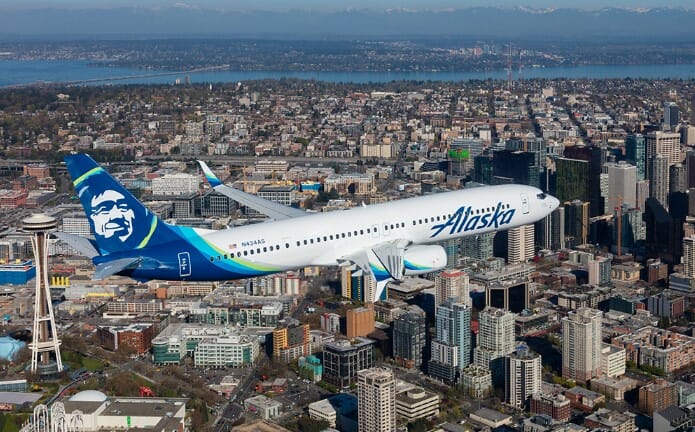Sidenote: The Alaska Air Group consists of Alaska Airlines (mainline) and Horizon Air (regional) airlines.
I just attended a fireside chat webinar with Alaska Airlines Chairman and CEO, Brad Tilden. Brad shares where Alaska Airlines is today and where they expect to be in the future. Here is a summary of the webinar.

Opening Comments
Brad started off by making some comments about the current situation at the Alaska Air Group.
Due to 2018 and 2019 being very robust years for Alaska, they were able to pay off the debt early to purchase Virgin American which was paid last year.
During the early days of Covid-19, the airline experienced:
- 55 days where cancellations exceeded reservations,
- 30 days where refunds exceeded revenue,
- The average number of daily passengers went from 130,000 per day to 4,000 per day.
The airline did see an increase in passenger traffic beginning Memorial Day weekend and they flew 40,000 passengers yesterday. Even though the uptick has begun, Brad does not see the airline getting back to pre-COVID-19 levels until the summer of 2021 at the earliest.
Restart Priorities
Brad was very clear that the main focus of Alaska is safety. This is really important because there have been employees that have been off work and aircraft that have been parked. Both employees and aircraft will need time and effort to get back online. Alaska has a system called READY-SAFE-GO that they implemented a couple of years ago. The bottom line before any flight departure is “we don’t have to go”. The air group has gone from 1,300 flights per day to as little as 150, working back up to 600 flights per day.
Changes to employee and customer safety is the new norm. Last month, they launched the Next-Level Care program. The program factors include:
- Sanitation,
- Aircraft cleanliness,
- face masks,
- social distancing,
- aircraft cabin air filtration and
- changes to inflight service.
The airline wants its passengers to feel when I fly Alaska, I feel safe. Brad said that he wants the customers to see the changes to cleanliness, social distancing and cleanliness so they feel safe. This is part of the airlines’ culture of care and respect to keep passengers safe.
The check-in process has changed June 30th, guests will be required to take a health agreement during check-in to verify that they haven’t exhibited COVID symptoms in the past 72 hours, didn’t travel with someone who is symptomatic and agrees to bring and wear a mask. He said that flight attendants at Alaska Airlines are very good at diffusing situations about the aircraft and the new “yellow card” procedure should help maintain face mask compliance.
Network Restoration
Brad started by distinguishing between the customer problem and the revenue problem. Alaska will restore service where and when the airline believes it’s safe to. Here are some of the considerations regarding network restoration:
- Leisure vs. business. The business sector may never return so the focus is on leisure travel,
- Cabin fever – people want to get out,
- Vacation destination flights,
- Weaker results for transcon flights,
- Hawaii – the current quarantine in Hawaii is hurting all airlines. Hawaii is set to relax quarantine restrictions on August 1, 2020,
- Alaska – Alaska has similar requirements for visitors to Alaska. He also noted that the Alaska cruise industry is dead for 2020 and
- Horizon Air – the regional arm of Alaska is still doing reasonably well.
Customer Loyalty
Like most airlines, Alaska Airlines has extended 2020 elite status through the 2021 benefit year. Members of the Alaska Lounge have seen they lounge memberships extend. The airline has announced enhancements for its frequent flyer program which has some generous bonus opportunities. Alaska is working on marketing efforts to drive sales to vacation destinations.
Does Alaska Have Any Advantage Over Their Competitors During Recovery?
Brad basically pointed to some key areas where they believe they will do better than their competitors during the recovery period. They are:
- Domestic route structure – Aside from service to Mexico and Costa Rica, Alaska is focused on a robust domestic route structure,
- Narrow-body aircraft – Alaska airlines only flies narrow-body aircraft which gives them a reduced aircraft type in their fleet,
- Business travel – Alaska thinks that they will recover business travel due to their west coast routes,
- Vacation destinations – The airline will continue to focus on the leisure traveler and vacation destinations and
- A lower-fare and lower operating cost structure.
The Leadership Team at Alaska is busy forecasting a balance in size and position within the industry.
Joining The Oneworld Alliance
The first thing to understand is the on-again, off-again relationship with American Airlines. This relationship was headed to divorce court earlier this year until American Airlines realized that it is cheaper to keep her. American came to the conclusion that they needed Alaska Airlines to fend of attacks from Delta, especially on the west coast. Instead of a divorce, the relationship got a honeymoon with enhanced benefits. It is this relationship that Alaska is entering the Oneworld Alliance through an invitation from American Airlines to join.
The COVID-19 situation actually might speed up the initiation into Oneworld. Alaska was set to join Oneworld in the summer of 2021 but that might happen as early as the end of this year. Brad said that customers of Alaska Airlines are doing more international flying and that membership in Oneworld will be a big plus for customers of Alaska. Alaska has maintained partnerships with many of the airlines in Oneworld so this alliance makes sense for Alaska Airlines.
Alaska Air Group Fleetplan
This was the question that generated the most interest in the webinar. The current fleet consists of 225 mainline (B737, A320) and 100 regional (E175, Q400) aircraft. The airline has sent the fleet of Airbus A-319 to retirement. The fleet reduction will include more Airbus Aircraft than Boeing. The long-term fleet structure is six to 12-months from being finalized. Brad said that the A-320 and the 737-800 have similar performance and the A-321 is an excellent aircraft. He did mention that there are advantages to operating a single fleet and having their headquarters in Seattle.
Brad did say that he has confidence in the Boeing 737MAX aircraft and there are two MAX aircraft on the ramp at Boeing for delivery to Alaska. He went on to say that historically, Boeing has been a leader in safety and he has no reservations about the 737MAX after the FAA recertifies the aircraft.
Alaska Airlines really likes the E-175 regional jets. He said that customers do too with the three-class seating that includes 12 first class seats. They plan to move some E-175 aircraft to Alaska to serve cities where there are low populations especially during shoulder seasons. Some flights operate with 35 passengers or less. This move also is in response to the bankruptcy of Alaska carrier Ravn.
Finance
During the early days of COVID-19, the airline was burning through $15 million per day. They have gotten that down to $4 million per day and they hope to have that down to zero by the end of the year. They expect to be profitable in 2021.
The great unknown is what happens if COVID-19 resurges in the third and fourth quarters. They think there is a silver lining with the safety policies that they have put in place. The outlook for fares should be lower until the market returns.
The Middle Seat
Alaska has committed to leaving middle seats until through July, 2020. They expect that load caps will vary depending on route markets. To leave middle seats open during the long-term, fares would have to go up. This will depend on what the customers want and how much they are willing to pay.
Mobile Apps And Technology
Alaska has always embraced technology. They were the first airline to sell airline tickets on the internet and use check-in kiosks. Brad said the mobile is the way but they do not want to go faster than their customers are ready for. The goal is for less interaction at the ticket counters. Six months ago, Alaska created an Innovation Division to develop new functions.
The Environment And Sustainability
Alaska continues to work on lowering emissions per passenger and sustainable fuels. They are looking for profound solutions with bigger gains than smaller gains. Customers have let the airline know that they believe airlines should have a lower environmental footprint.
Final Thoughts
I was really impressed by the direction and actions of Alaska Airlines to manage their finances and keep customer loyalty. They look like they are in a better position to recover than the big three carriers. They have a lot of work ahead but they also have a great leader in Brad Tilted who has worked his way up the airline ranks at Alaska.





